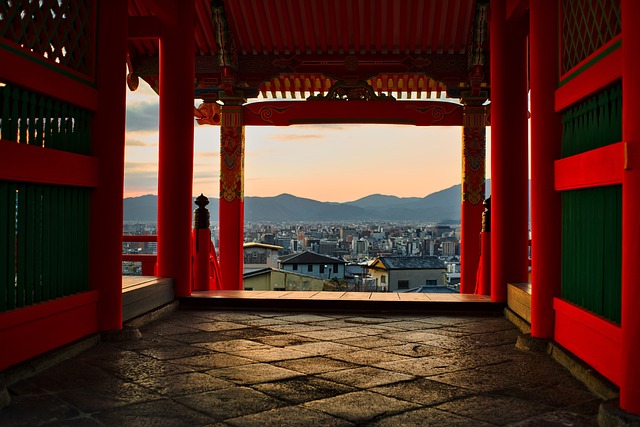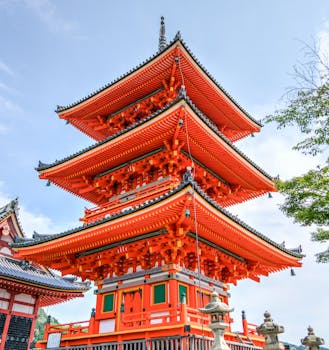-
Table of Contents
- History of Kiyomizu-dera
- Architectural features of Kiyomizu-dera
- Significance of the Main Hall in Kiyomizu-dera
- Exploring the stunning views from Kiyomizu-dera
- Rituals and ceremonies at Kiyomizu-dera
- Legends and folklore associated with Kiyomizu-dera
- Seasonal events and festivals at Kiyomizu-dera
- Nearby attractions and activities around Kiyomizu-dera
- Tips for visiting Kiyomizu-dera and experiencing its tranquility
- Q&A
“Kiyomizu-dera: Where ancient beauty meets spiritual serenity.”
Kiyomizu-dera is a historic Buddhist temple located in eastern Kyoto, Japan. It is one of the most famous and iconic landmarks in the city, known for its stunning architecture, scenic views, and cultural significance. The temple was founded in 778 and has since become a UNESCO World Heritage site. Kiyomizu-dera is particularly renowned for its wooden terrace, which offers panoramic views of Kyoto and its surroundings. It is also home to several other notable structures, including the Otawa Waterfall and the Jishu Shrine. The temple attracts millions of visitors each year, who come to admire its beauty, experience its spiritual atmosphere, and immerse themselves in Japanese history and culture.
History of Kiyomizu-dera
Kiyomizu-dera, a renowned Buddhist temple located in Kyoto, Japan, has a rich and fascinating history that spans over 1,200 years. This ancient temple, also known as the “Pure Water Temple,” holds great significance in Japanese culture and is a popular tourist destination for both locals and foreigners alike.
The history of Kiyomizu-dera dates back to the early Heian period, when it was founded in 778 by the monk Enchin. Legend has it that Enchin was inspired to build the temple after he had a vision of the Bodhisattva Avalokitesvara, who appeared to him in the form of a waterfall. This vision led Enchin to believe that the site was sacred and had the power to grant wishes.
During its early years, Kiyomizu-dera was a small wooden structure that served as a place of worship for the followers of the Hosso sect of Buddhism. However, in 798, the temple was destroyed by a powerful earthquake. Undeterred by this setback, the temple was rebuilt and expanded over the centuries, becoming the magnificent complex that we see today.
One of the most remarkable features of Kiyomizu-dera is its main hall, known as the Hondo. This wooden structure, supported by massive wooden pillars, was built without the use of any nails. The construction of the Hondo is a testament to the exceptional craftsmanship of the time and is considered a national treasure of Japan.
Another notable feature of Kiyomizu-dera is its famous wooden terrace, known as the Kiyomizu Stage. This platform extends out from the main hall and offers breathtaking panoramic views of the surrounding area, including the city of Kyoto and the nearby Otawa Waterfall. The Kiyomizu Stage is particularly popular during the cherry blossom season when visitors can enjoy the stunning views while surrounded by a sea of blooming sakura trees.
Throughout its history, Kiyomizu-dera has undergone several renovations and reconstructions due to natural disasters and fires. However, each time it was rebuilt, the temple managed to retain its original architectural style and charm. The most recent major renovation took place in 1633, during the Edo period, when the temple was reconstructed under the patronage of the Tokugawa shogunate.
In addition to its architectural beauty, Kiyomizu-dera is also known for its religious significance. The temple is dedicated to the Buddhist deity Kannon, who is believed to be the embodiment of compassion. Many visitors come to Kiyomizu-dera to pray for good fortune, love, and success in their endeavors. The temple’s sacred spring, Otawa Waterfall, is believed to have healing properties, and visitors often drink from its waters in the hopes of receiving blessings.
In conclusion, the history of Kiyomizu-dera is a testament to the enduring legacy of this ancient temple. From its humble beginnings in the Heian period to its present-day status as a UNESCO World Heritage site, Kiyomizu-dera has captivated visitors with its architectural beauty, breathtaking views, and spiritual significance. Whether you are a history enthusiast, a nature lover, or a spiritual seeker, a visit to Kiyomizu-dera is sure to leave a lasting impression.
Architectural features of Kiyomizu-dera
Kiyomizu-dera, located in Kyoto, Japan, is a renowned Buddhist temple that dates back to the 8th century. This ancient temple is not only a significant religious site but also a remarkable architectural masterpiece. Its unique features and design elements make it a must-visit destination for tourists and architecture enthusiasts alike.
One of the most striking architectural features of Kiyomizu-dera is its wooden structure. The entire temple complex, including the main hall and the surrounding buildings, is constructed without the use of any nails. This traditional method of construction, known as “sukiya-zukuri,” showcases the exceptional craftsmanship of the Japanese artisans of that time. The intricate joinery techniques used in the construction of Kiyomizu-dera not only provide structural stability but also add to the temple’s aesthetic appeal.
The main hall of Kiyomizu-dera, known as the Hondo, is perched on a steep hillside, supported by a series of massive wooden pillars. This elevated position gives visitors a breathtaking view of the surrounding landscape, including the city of Kyoto and the nearby Otawa Waterfall. The Hondo’s large veranda, known as the Kiyomizu Stage, is another notable feature. This stage extends out from the main hall, seemingly floating in mid-air, and offers visitors a unique vantage point to admire the temple’s surroundings.
Another architectural highlight of Kiyomizu-dera is its iconic wooden balcony, known as the Taho-to Pagoda. This five-story pagoda, adorned with intricate carvings and vibrant colors, stands tall against the backdrop of the temple complex. The Taho-to Pagoda not only serves as a symbol of Kiyomizu-dera but also provides a visual focal point for visitors as they explore the temple grounds.
As visitors make their way through the temple complex, they will come across the Jishu Shrine, dedicated to the deity of love and matchmaking. This shrine is known for its “love stones,” two large rocks placed about 18 meters apart. Legend has it that if visitors can successfully walk from one stone to the other with their eyes closed, their wishes for love will come true. The Jishu Shrine’s architectural design, with its intricate wooden carvings and vibrant colors, adds to the mystical atmosphere of the shrine.
In addition to these architectural features, Kiyomizu-dera is also known for its beautiful gardens. The temple grounds are meticulously landscaped, with lush greenery, serene ponds, and vibrant flowers. These gardens not only enhance the overall aesthetic appeal of the temple but also provide a tranquil space for visitors to relax and reflect.
In conclusion, Kiyomizu-dera is a remarkable architectural masterpiece that showcases the rich cultural heritage of Japan. Its wooden structure, unique design elements, and breathtaking views make it a must-visit destination for anyone interested in architecture or Japanese history. Whether it’s the Hondo’s elevated position, the Taho-to Pagoda’s vibrant colors, or the Jishu Shrine’s mystical atmosphere, Kiyomizu-dera offers a truly immersive experience for visitors. So, if you find yourself in Kyoto, don’t miss the opportunity to explore this awe-inspiring temple and immerse yourself in its architectural wonders.
Significance of the Main Hall in Kiyomizu-dera
Kiyomizu-dera, a Buddhist temple located in Kyoto, Japan, is renowned for its stunning architecture and rich cultural significance. Among its many notable features, the Main Hall stands out as a testament to the temple’s historical and spiritual importance. This article will delve into the significance of the Main Hall in Kiyomizu-dera, shedding light on its architectural marvels and the religious practices that take place within its sacred walls.
The Main Hall, also known as the Hondo, is the heart of Kiyomizu-dera. Built without the use of any nails, this wooden structure is a masterpiece of traditional Japanese architecture. Its construction, completed in 1633, showcases the skill and craftsmanship of the artisans of that era. The Main Hall’s unique design, with its large veranda jutting out over the hillside, offers visitors breathtaking panoramic views of the surrounding landscape, including the city of Kyoto and the nearby Otawa Waterfall.
Beyond its architectural splendor, the Main Hall holds immense religious significance. It is dedicated to the Buddhist deity Kannon, the goddess of mercy and compassion. Devotees flock to Kiyomizu-dera to pay their respects to Kannon and seek blessings for themselves and their loved ones. The Main Hall serves as a place of worship, where visitors can offer prayers and make offerings to the deity.
One of the most cherished rituals that takes place in the Main Hall is the Otawa Waterfall purification. Pilgrims line up to drink from three streams of water flowing from the Otawa Waterfall, each believed to grant a different kind of blessing. The water is said to have healing properties and is believed to bring good fortune, academic success, and longevity. This ritual is a powerful symbol of purification and renewal, as visitors cleanse their bodies and minds before entering the sacred space of the Main Hall.
Inside the Main Hall, visitors can also witness the practice of goma, a fire ritual performed by Buddhist monks. Goma involves the burning of wooden sticks and recitation of mantras to invoke spiritual energy and dispel negative forces. The flames dance and crackle, creating an atmosphere of reverence and awe. This ancient ritual is believed to bring protection, healing, and spiritual transformation to those who witness it.
The Main Hall is not only a place of worship but also a cultural hub. It serves as a venue for various traditional performances and events throughout the year, including tea ceremonies, musical performances, and cultural festivals. These events showcase the rich heritage and artistic traditions of Japan, allowing visitors to immerse themselves in the vibrant cultural tapestry of the country.
In conclusion, the Main Hall in Kiyomizu-dera holds immense significance both architecturally and spiritually. Its awe-inspiring design and panoramic views make it a must-visit destination for tourists. Moreover, the Main Hall serves as a sacred space for worship, where devotees can seek blessings and participate in rituals that connect them to the divine. Whether one is drawn to its architectural marvels, religious practices, or cultural events, the Main Hall in Kiyomizu-dera offers a profound and enriching experience for all who visit.
Exploring the stunning views from Kiyomizu-dera

Kiyomizu-dera is a renowned Buddhist temple located in Kyoto, Japan. It is known for its stunning views of the city and its unique architectural design. The temple, which translates to “Pure Water Temple,” was founded in 778 and has since become one of the most popular tourist attractions in Kyoto.
One of the main highlights of Kiyomizu-dera is its expansive wooden terrace, which offers breathtaking panoramic views of the surrounding area. From this vantage point, visitors can see the cityscape of Kyoto, with its traditional rooftops and modern buildings blending harmoniously. The view is particularly spectacular during the cherry blossom season when the temple is surrounded by a sea of pink flowers.
To reach the terrace, visitors must first navigate a steep and narrow stone pathway. This pathway, known as the Otawa Waterfall, is believed to have healing powers. Visitors can drink from one of three streams of water flowing from the waterfall, each said to bring a different benefit – longevity, success in studies, or a fortunate love life. This ritual has become a popular tradition among visitors to Kiyomizu-dera.
Once on the terrace, visitors can also admire the temple’s main hall, which is an architectural marvel in itself. The hall is supported by massive wooden pillars and does not use a single nail in its construction. This impressive feat of engineering is a testament to the skill and craftsmanship of the temple’s builders.
Another notable feature of Kiyomizu-dera is its pagoda, a five-story structure that stands tall against the backdrop of the temple complex. The pagoda is adorned with intricate carvings and offers a glimpse into the rich history and culture of Japan. Visitors can climb to the top of the pagoda for an even more breathtaking view of the surrounding area.
Aside from its architectural wonders, Kiyomizu-dera is also a place of spiritual significance. The temple is dedicated to the Buddhist deity Kannon, the goddess of mercy. Many visitors come to Kiyomizu-dera to pray for good fortune, health, and happiness. The serene atmosphere and the sound of chanting monks create a sense of tranquility and peace, making it an ideal place for meditation and reflection.
In addition to its main attractions, Kiyomizu-dera is surrounded by a beautiful forested area known as the Otawa Mountain. This area is home to several smaller shrines and temples, as well as walking trails that lead visitors through lush greenery and serene landscapes. Exploring the Otawa Mountain allows visitors to experience the natural beauty of the area and provides a peaceful retreat from the bustling city.
In conclusion, Kiyomizu-dera offers a unique and awe-inspiring experience for visitors. From its stunning views of Kyoto to its impressive architecture and spiritual significance, the temple is a must-visit destination for anyone traveling to Japan. Whether you are interested in history, culture, or simply seeking a moment of tranquility, Kiyomizu-dera has something to offer. So, make sure to include this iconic temple in your itinerary when exploring Kyoto.
Rituals and ceremonies at Kiyomizu-dera
Kiyomizu-dera, a Buddhist temple located in Kyoto, Japan, is not only renowned for its stunning architecture and breathtaking views but also for its rich history of rituals and ceremonies. These rituals and ceremonies play a significant role in the spiritual life of the temple and its visitors, providing a unique and immersive experience.
One of the most notable rituals at Kiyomizu-dera is the morning prayer ceremony, known as “Otsutome.” This daily ritual takes place in the main hall of the temple, where monks and visitors gather to offer their prayers and participate in chanting. The solemn atmosphere and the rhythmic chants create a sense of tranquility and devotion, allowing participants to connect with their inner selves and find solace in the spiritual realm.
Another important ceremony at Kiyomizu-dera is the “Goma” ritual. Goma, which translates to “fire ritual,” is a purification ceremony performed to ward off evil spirits and bring good fortune. During this ceremony, a sacred fire is lit, and offerings such as wooden sticks with wishes written on them are thrown into the fire. The crackling sound of the fire and the sight of the smoke rising into the air create a mystical ambiance, symbolizing the purification of the participants’ hearts and minds.
In addition to these daily rituals, Kiyomizu-dera also hosts special ceremonies throughout the year to celebrate various occasions. One such ceremony is the “Hatsuuma” ritual, held on the first day of the horse in the lunar calendar. This ceremony is believed to bring good luck and prosperity for the year ahead. Participants gather at the temple, where they receive blessings from the monks and offer prayers for their wishes to come true. The vibrant atmosphere, filled with traditional music and colorful decorations, adds to the festive spirit of the occasion.
Another significant event at Kiyomizu-dera is the “Mizuage” ceremony, which takes place during the summer months. Mizuage, meaning “water raising,” is a ritual where water from the Otawa waterfall, located within the temple grounds, is collected and offered to visitors. This water is believed to have healing properties and is said to bring good health and fortune. Participants line up to receive a cup of the sacred water, which they drink or use to cleanse their hands and faces, symbolizing the purification of their bodies and souls.
The rituals and ceremonies at Kiyomizu-dera not only provide a spiritual experience but also offer a glimpse into the rich cultural heritage of Japan. Visitors from all over the world come to witness and participate in these rituals, seeking spiritual solace and a deeper connection with the traditions of the temple. The serene atmosphere, the enchanting chants, and the sense of unity among the participants create a profound and unforgettable experience.
In conclusion, Kiyomizu-dera is not just a magnificent architectural wonder but also a place where rituals and ceremonies hold great significance. From the morning prayer ceremony to the Goma ritual and the special events throughout the year, these rituals provide a unique opportunity for visitors to immerse themselves in the spiritual traditions of Japan. Whether seeking solace, purification, or good fortune, the rituals and ceremonies at Kiyomizu-dera offer a transformative experience that leaves a lasting impression on all who participate.
Legends and folklore associated with Kiyomizu-dera
Kiyomizu-dera, a Buddhist temple located in Kyoto, Japan, is not only renowned for its stunning architecture and panoramic views, but also for the rich legends and folklore that surround it. These tales have been passed down through generations, adding an air of mystique and enchantment to this sacred place.
One of the most famous legends associated with Kiyomizu-dera is the story of the Otawa Waterfall. According to the legend, a Buddhist monk named Enchin had a vision of a sacred waterfall in his dreams. Inspired by this vision, he embarked on a journey to find the waterfall and eventually discovered it in the hills of Kyoto. This waterfall, known as Otawa, is believed to have healing powers, and visitors to Kiyomizu-dera often line up to drink its pure water, hoping for good health and fortune.
Another intriguing legend connected to Kiyomizu-dera is the tale of the “Lover’s Stone.” It is said that if a person successfully walks from one stone to another, blindfolded, with the help of a loved one, their wish for a successful romantic relationship will come true. Many couples visit Kiyomizu-dera to test their love and faith in each other by attempting this challenge. The Lover’s Stone has become a symbol of love and commitment, attracting countless visitors seeking to strengthen their relationships.
In addition to these legends, Kiyomizu-dera is also associated with a famous folktale called “The Love Stone.” This tale tells the story of a young couple who fell deeply in love but were tragically separated by war. The woman, unable to bear the pain of their separation, turned into a stone and waited for her lover to return. It is believed that if two people touch this stone simultaneously, their love will be eternal. This folktale has become a symbol of enduring love and draws many couples to Kiyomizu-dera in search of everlasting happiness.
Furthermore, Kiyomizu-dera is steeped in history and has witnessed numerous historical events. One such event is the Battle of Uji, which took place in the 12th century. During this battle, the temple served as a strategic location for the Minamoto clan, who sought to overthrow the Taira clan. The temple’s elevated position provided a vantage point for the Minamoto warriors, giving them a significant advantage in the battle. Today, visitors can still see the remnants of the defensive walls and gates that were built during this time, serving as a reminder of the temple’s historical significance.
In conclusion, Kiyomizu-dera is not only a magnificent architectural marvel but also a place steeped in legends and folklore. The stories of the Otawa Waterfall, the Lover’s Stone, and “The Love Stone” add an element of enchantment and mystique to this sacred temple. Additionally, the temple’s historical significance, particularly its role in the Battle of Uji, further enhances its allure. Whether visitors come seeking good health, love, or a glimpse into Japan’s rich history, Kiyomizu-dera offers a truly captivating experience that leaves a lasting impression on all who visit.
Seasonal events and festivals at Kiyomizu-dera
Kiyomizu-dera, a renowned Buddhist temple located in Kyoto, Japan, is not only a place of spiritual significance but also a hub of cultural celebrations and seasonal events. Throughout the year, this temple hosts a variety of festivals that attract both locals and tourists alike, offering a unique opportunity to immerse oneself in the rich traditions and customs of Japan.
One of the most anticipated events at Kiyomizu-dera is the cherry blossom festival, held in spring when the temple’s surroundings are adorned with the delicate pink blooms. As visitors enter the temple grounds, they are greeted by a breathtaking sight, with cherry blossoms cascading down the hillside, creating a picturesque backdrop for the temple’s iconic wooden structure. The festival features traditional music and dance performances, tea ceremonies, and stalls selling local delicacies. It is a time when people come together to celebrate the beauty of nature and the fleeting nature of life, as symbolized by the ephemeral cherry blossoms.
As the seasons change and summer arrives, Kiyomizu-dera transforms into a vibrant hub of activity with the celebration of the Gion Matsuri festival. This month-long festival, dating back over a thousand years, is one of Japan’s most famous and attracts millions of visitors from all over the world. The highlight of the festival is the grand procession of elaborately decorated floats, known as yamaboko, which are paraded through the streets of Kyoto. The temple plays a significant role in this festival, as it is believed to protect the city from disaster. During this time, the temple is adorned with lanterns, creating a magical atmosphere as visitors explore the temple grounds and participate in various traditional games and performances.
Autumn brings its own charm to Kiyomizu-dera with the celebration of the Momiji Matsuri, or the Maple Leaf Festival. As the leaves on the surrounding maple trees turn vibrant shades of red, orange, and gold, the temple becomes a haven for nature enthusiasts and photographers. The festival showcases traditional Japanese arts and crafts, such as calligraphy and pottery, allowing visitors to appreciate the beauty of autumn while also learning about the country’s cultural heritage. Additionally, visitors can enjoy seasonal treats like maple leaf-shaped sweets and warm cups of matcha tea, further enhancing the experience.
Finally, as winter sets in, Kiyomizu-dera welcomes visitors to celebrate the New Year with a special ceremony known as Joya-no-Kane. This traditional Buddhist ritual involves ringing the temple’s massive bell 108 times, symbolizing the purification of the 108 worldly desires. As the bell resonates through the crisp winter air, visitors can reflect on the past year and set intentions for the year ahead. The temple is adorned with festive decorations, and visitors can also participate in traditional activities such as writing wishes on wooden plaques and enjoying hot bowls of ozoni, a traditional New Year’s soup.
In conclusion, Kiyomizu-dera offers a plethora of seasonal events and festivals that allow visitors to immerse themselves in the rich cultural heritage of Japan. From the ethereal beauty of cherry blossoms in spring to the grandeur of the Gion Matsuri festival in summer, the temple provides a unique and unforgettable experience throughout the year. Whether it’s witnessing the vibrant autumn foliage during the Maple Leaf Festival or participating in the New Year’s ceremony, Kiyomizu-dera offers a glimpse into the traditions and customs that have shaped Japan’s cultural identity.
Nearby attractions and activities around Kiyomizu-dera
Kiyomizu-dera, a renowned Buddhist temple located in Kyoto, Japan, is not only a popular tourist destination in its own right but also offers a plethora of nearby attractions and activities for visitors to explore. From historical landmarks to traditional cultural experiences, there is something for everyone in the vicinity of Kiyomizu-dera.
One of the most notable nearby attractions is the iconic Yasaka Pagoda. Standing at an impressive height of 46 meters, this five-story pagoda is a symbol of Kyoto and offers breathtaking views of the city from its top floor. Visitors can climb the stairs to each level, taking in the intricate architectural details and enjoying the panoramic vistas along the way. The pagoda is especially enchanting during the cherry blossom season when the surrounding trees are in full bloom, creating a picturesque scene that is truly unforgettable.
For those interested in immersing themselves in traditional Japanese culture, a visit to the nearby Gion district is a must. Known for its preserved historic streets and traditional wooden machiya houses, Gion is the perfect place to experience the charm of old Kyoto. Visitors can stroll along Hanamikoji Street, lined with traditional tea houses and restaurants, and may even catch a glimpse of a geisha or maiko (apprentice geisha) gracefully making their way to an appointment. Gion also offers a variety of shops selling traditional crafts, such as pottery and kimono, allowing visitors to take a piece of Kyoto’s rich cultural heritage home with them.
Another nearby attraction that should not be missed is Maruyama Park. Located just a short walk from Kiyomizu-dera, this spacious park is a popular spot for locals and tourists alike, especially during the cherry blossom season. With over 680 cherry trees, Maruyama Park becomes a sea of pink and white blossoms, attracting visitors from all over the world. The park also features a large pond, a teahouse, and several walking paths, providing a tranquil escape from the bustling city.
For those seeking a more immersive cultural experience, a visit to a traditional tea ceremony house is highly recommended. Located near Kiyomizu-dera, these tea houses offer visitors the opportunity to participate in a traditional tea ceremony, where they can learn about the art of tea preparation and enjoy a cup of matcha (powdered green tea) in a serene setting. The tea ceremony is not only a chance to taste the unique flavors of Japanese tea but also a way to appreciate the mindfulness and tranquility that is deeply ingrained in Japanese culture.
In conclusion, Kiyomizu-dera is not only a magnificent temple in its own right but also serves as a gateway to a multitude of nearby attractions and activities. From the awe-inspiring Yasaka Pagoda to the enchanting streets of Gion, visitors can immerse themselves in the rich history and culture of Kyoto. Whether it’s enjoying the beauty of cherry blossoms in Maruyama Park or participating in a traditional tea ceremony, there is no shortage of experiences to be had in the vicinity of Kiyomizu-dera. So, when planning a visit to this iconic temple, be sure to set aside time to explore the nearby attractions and make the most of your time in Kyoto.
Tips for visiting Kiyomizu-dera and experiencing its tranquility
Kiyomizu-dera is a renowned Buddhist temple located in Kyoto, Japan. Known for its stunning architecture and serene atmosphere, it attracts millions of visitors each year. If you’re planning a visit to Kiyomizu-dera, here are some tips to help you make the most of your experience and immerse yourself in its tranquility.
First and foremost, it’s important to plan your visit to Kiyomizu-dera during the right time of year. The temple is particularly beautiful during the cherry blossom season in spring when the surrounding trees are in full bloom, creating a picturesque backdrop. Autumn is also a great time to visit, as the vibrant colors of the changing leaves add a touch of magic to the temple’s surroundings. Avoiding peak tourist seasons will allow you to enjoy a more peaceful and intimate experience.
When you arrive at Kiyomizu-dera, take a moment to appreciate the temple’s impressive wooden structure. Built without the use of any nails, it stands as a testament to the skill and craftsmanship of ancient Japanese architects. As you explore the temple grounds, you’ll come across various halls and pagodas, each with its own unique charm. Be sure to visit the main hall, which offers a breathtaking view of Kyoto from its spacious wooden terrace.
To fully immerse yourself in the tranquility of Kiyomizu-dera, consider participating in a traditional tea ceremony. These ceremonies are held in the temple’s tea house and provide a serene and meditative experience. Sip on a cup of matcha tea while enjoying the peaceful surroundings, and let the calming atmosphere wash over you.
As you wander through the temple grounds, take the time to explore the beautiful gardens that surround Kiyomizu-dera. These meticulously manicured landscapes are designed to create a sense of harmony and balance. Stroll along the winding paths, admire the vibrant flowers, and listen to the soothing sound of water flowing in the nearby streams and ponds. The gardens offer a peaceful retreat from the bustling city and provide an opportunity for quiet contemplation.
While visiting Kiyomizu-dera, it’s important to respect the temple’s rules and customs. Remember to dress modestly and remove your shoes before entering any of the buildings. Be mindful of your surroundings and avoid making loud noises or engaging in disruptive behavior. This will ensure that both you and other visitors can fully appreciate the tranquility of the temple.
Before leaving Kiyomizu-dera, consider purchasing a small souvenir to commemorate your visit. The temple’s gift shop offers a variety of traditional Japanese crafts and trinkets, such as handmade pottery and wooden charms. These items make for meaningful keepsakes and serve as a reminder of the serenity you experienced at Kiyomizu-dera.
In conclusion, a visit to Kiyomizu-dera is a must for anyone seeking tranquility and a deeper understanding of Japanese culture. By planning your visit during the right season, appreciating the temple’s architecture, participating in a tea ceremony, exploring the gardens, respecting the temple’s customs, and purchasing a souvenir, you can fully immerse yourself in the serene atmosphere of this remarkable Buddhist temple. So, take your time, embrace the tranquility, and let Kiyomizu-dera leave a lasting impression on your soul.
Q&A
1. What is Kiyomizu-dera?
Kiyomizu-dera is a famous Buddhist temple located in Kyoto, Japan.
2. When was Kiyomizu-dera built?
Kiyomizu-dera was originally built in 778 AD, but the current buildings date back to 1633.
3. What is the significance of Kiyomizu-dera?
Kiyomizu-dera is known for its wooden terrace that offers panoramic views of Kyoto. It is also a UNESCO World Heritage site and is considered an important cultural and historical landmark.
4. How did Kiyomizu-dera get its name?
The name “Kiyomizu-dera” translates to “Pure Water Temple” in English, referring to the Otawa Waterfall within the temple complex.
5. What are the main attractions at Kiyomizu-dera?
The main attractions at Kiyomizu-dera include the wooden terrace, the main hall, the Otawa Waterfall, and various shrines and pagodas within the temple grounds.
6. Is Kiyomizu-dera open to the public?
Yes, Kiyomizu-dera is open to the public and welcomes visitors throughout the year.
7. Are there any special events or festivals held at Kiyomizu-dera?
Yes, Kiyomizu-dera hosts several events and festivals throughout the year, including the Kiyomizu-dera Temple Autumn Special Night Illumination and the Kiyomizu-dera Temple Spring Special Night Illumination.
8. How can I get to Kiyomizu-dera?
Kiyomizu-dera is accessible by public transportation, including buses and trains. Visitors can take a bus to the Kiyomizu-michi bus stop or walk from nearby train stations.
9. Is there an entrance fee to visit Kiyomizu-dera?
Yes, there is an entrance fee to visit Kiyomizu-dera. The fee may vary depending on the season and any special events taking place.In conclusion, Kiyomizu-dera is a historic Buddhist temple located in Kyoto, Japan. It is known for its stunning architecture, including a large wooden terrace that offers panoramic views of the city. The temple is also famous for its sacred Otawa Waterfall, where visitors can drink from three different streams believed to grant various blessings. Kiyomizu-dera is a popular tourist attraction and a significant cultural and religious site in Japan.
![]()








